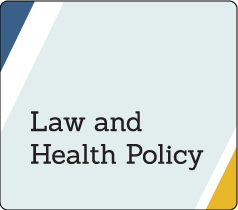This content was part of the Healthy People 2020 Law and Health Policy project, which ended in 2020.
Healthy People 2020 Law and Health Policy Project Webinar Summary
The Healthy People 2020 Law and Health Policy Project webinar held on June 13, 2019 — The Role of Law and Policy in Achieving Health Equity and Attaining Our Healthy People Objectives — examined resources to help individuals understand which legal and policy tools may be available for communities and stakeholders to use in efforts to promote health equity. The webinar featured the following presentations:
Carter Blakey, Deputy Director of the Department of Health and Human Services (HHS) Office of Disease Prevention and Health Promotion (ODPHP) and Director of the Division of Community Strategies, gave an overview of the Healthy People Initiative and the Law and Health Policy Project. She also explored the roles that legal and policy strategies have played in advancing public health.
Kim Libman, PhD, MPH, Program Director at ChangeLab Solutions, described Blueprint for Changemakers: Achieving Health Equity through Law & Policy, a how-to guide for communities as they explore how laws and policies can create lasting changes to help all residents live a healthy life.
Genoveva Islas, MPH, Director and Founder of Cultiva La Salud, shared her experience incorporating health equity tools into the transportation planning process to address inequities and improve health outcomes. Cultiva La Salud is a public health advocacy organization based in Fresno, California, that advocates for policy system and environmental improvements to foster active living and healthy eating.
About Healthy People and the Law and Health Policy Project: Carter Blakey, ODPHP
For several decades, Healthy People has been providing science-based national objectives and ambitious 10-year targets for improving the health of the nation. In this way, the initiative serves as a roadmap for health promotion and disease prevention efforts. It provides a way to understand where we are now, planning for where we need to be, and providing guidance on how to get there over the next ten-year period of time.
The Law and Health Policy Project was a collaboration between ODPHP, the Centers for Disease Control and Prevention (CDC), the CDC Foundation, and the Robert Wood Johnson Foundation (RWJF). It aimed to improve the health of communities through sharing information about evidence-based law and policy interventions. The project examined the relationship between population health and these interventions — specifically, how law and policy could be useful tools to improve health and reach the targets for specific Healthy People objectives.
Law and Health Policy Resources and Activities:
- In-depth topic-specific reports
- Bright Spots, which showcase ways legal and policy interventions can improve health in communities
- Webinar series highlighting legal and policy research and approaches to address public health
- Resources to support the development of Healthy People 2030
Health Equity in the Healthy People Initiative: Carter Blakey, ODPHP
Healthy People has grown over the decades, starting with 226 objectives in 1980 and growing to over 1,200 today. The number of topic areas have also increased alongside the research and evidence about what supports health—and new ways to track and measure it. In addition, Healthy People’s overarching goals increasingly recognize the importance of upstream impacts on health. Healthy People 2000 was the first to include language focused on reducing health disparities, which was strengthened in Healthy People 2010 with a call to eliminate health disparities. Healthy People 2020 included the first specific reference to achieving health equity, as well as an overarching goal that recognized the need for social and physical environments that promote health for all. To make these goals actionable, Healthy People also includes a data search tool to help stakeholders understand the difference in health conditions and behaviors across demographic groups.



